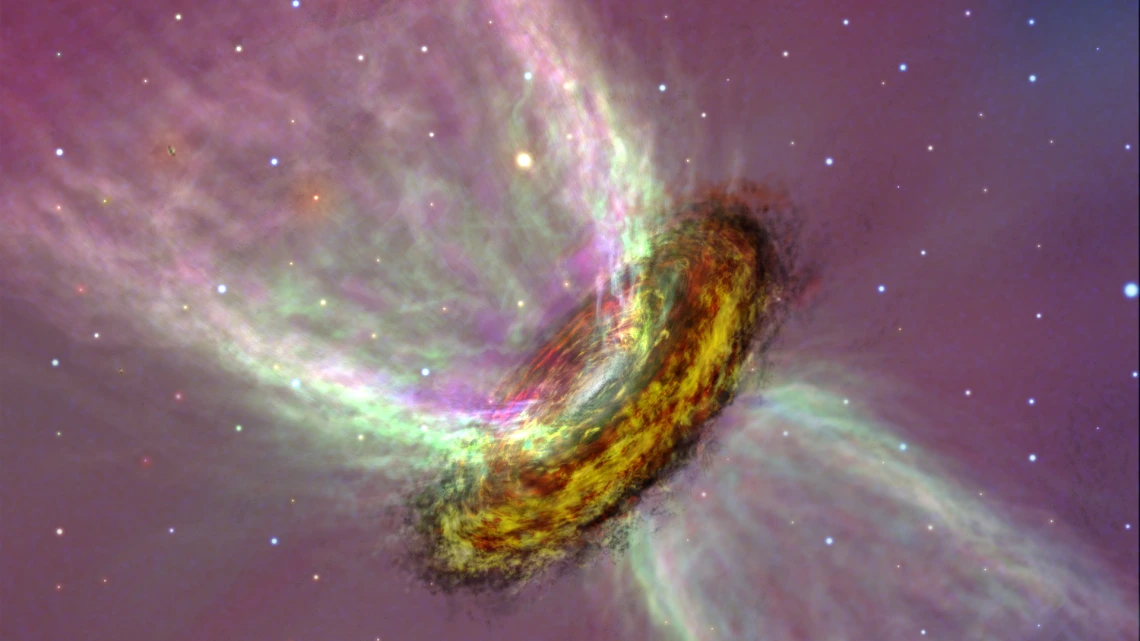Reviewed by Danielle Ellis, B.Sc.Oct 7 2024
A group of astronomers led by researchers from the University of Arizona used NASA’s James Webb Space Telescope to gather some of the most in-depth information on the forces that form protoplanetary disks, according to a study published in Nature Astronomy. The observations provide insights into the possible appearance of our solar system 4.6 billion years ago.
 This artist’s impression of a planet-forming disk surrounding a young star shows a swirling "pancake" of hot gas and dust from which planets form. Using the James Webb Space Telescope, researchers obtained detailed images showing the layered, conical structure of disk winds – streams of gas blowing out into space. Image Credit: National Astronomical Observatory of Japan
This artist’s impression of a planet-forming disk surrounding a young star shows a swirling "pancake" of hot gas and dust from which planets form. Using the James Webb Space Telescope, researchers obtained detailed images showing the layered, conical structure of disk winds – streams of gas blowing out into space. Image Credit: National Astronomical Observatory of Japan
Over 3,000 new stars are created every second in the visible universe. Astronomers refer to the whirling "pancake" of hot gas and dust that surrounds many as the protoplanetary disk, where planets form. However, little is known about the precise mechanisms that create stars and planetary systems.
The team was able to track so-called disk winds in unprecedented detail. These winds are gas streams that emerge from the planet-forming disk and travel into space. These winds, which are primarily powered by magnetic fields, can travel tens of miles in a single second. The researchers' findings will assist astronomers better understand how young planetary systems form and evolve.
According to the study’s lead author, Ilaria Pascucci, a professor at the University of Arizona Lunar and Planetary Laboratory, one of the most important processes at work in a protoplanetary disk is accretion, which involves a star eating matter from its surroundings.
How a star accretes mass has a big influence on how the surrounding disk evolves over time, including the way planets form later on. The specific ways in which this happens have not been understood, but we think that winds driven by magnetic fields across most of the disk surface could play a very important role.
Ilaria Pascucci, Professor, University of Arizona
Gas must first lose some of its inertia for young stars to grow by drawing in gas from the disk that is circling them. Otherwise, the gas would never fall on the star, but would instead continuously orbit it. This process, which astronomers refer to as “losing angular momentum,” has proven difficult to pinpoint.
To gain an understanding of how angular momentum works in a protoplanetary disk, imagine a figure skater on ice: Tucking her arms alongside her body speeds up her rotation while stretching them out and slowing it down. Since her mass does not change, her angular momentum remains constant.
Although astrophysicists cannot agree on the precise mechanism, gas across the disk must shed angular momentum for accretion to occur. Disk winds have become significant players in recent years, removing some gas from the disk surface along with its angular momentum. This allows the remaining gas to flow inward and eventually land on the star.
The second author of the study, Tracy Beck of NASA’s Space Telescope Science Institute, said it is important to be able to differentiate between the various phenomena because other processes shape protoplanetary disks.
The star’s magnetic field pushes material out of the disk’s inner edge in a process called X-wind, while intense starlight erodes the disk’s outer regions, creating so-called thermal winds that blow at much slower speeds.
To distinguish between the magnetic field-driven wind, the thermal wind, and X-wind, we really needed the high sensitivity and resolution of JWST (the James Webb Space Telescope).
Tracy Beck, AURA Observatory Scientist, Space Telescope Science Institute, NASA
The winds seen in this study come from a wider area, which would include the inner, rocky planets of our solar system, roughly between Earth and Mars, in contrast to the narrowly focused X-wind. Additionally, these winds reach hundreds of times the distance between Earth and the sun, extending farther above the disk than thermal winds.
“Our observations strongly suggest that we have obtained the first images of the winds that can remove angular momentum and solve the longstanding problem of how stars and planetary systems form,” Pascucci stated.
Four protoplanetary disk systems that appear edge-on from Earth were chosen by the researchers for their study.
Their orientation allowed the dust and gas in the disk to act as a mask, blocking some of the bright central star's light, which otherwise would have overwhelmed the winds.
Naman Bajaj, Graduate Student, Lunar and Planetary Laboratory, University of Arizona
The team traced different wind layers by adjusting JWST's detectors to detect different molecules in specific transition states. A central jet, nested inside a cone-shaped envelope of winds originating at increasingly larger disk distances, was revealed by the observations to have a complex, three-dimensional structure akin to an onion’s layers.
The researchers said that the consistent observation of a prominent central hole inside the cones, created by molecular winds in each of the four disks, was a significant new discovery.
Pascucci’s team then intends to extend these observations to additional protoplanetary disks to understand better the frequency of the observed disk wind structures in the universe and their evolution over time.
Pascucci concluded, “We believe they could be common, but with four objects, it's a bit difficult to say. We want to get a larger sample with James Webb, and then also see if we can detect changes in these winds as stars assemble and planets form.”
The European Research Council and NASA provided funding for this study.
Journal Reference:
Pascucci, I. et. al. (2024) The nested morphology of disk winds from young stars revealed by JWST/NIRSpec observations. Nature Astronomy. doi.org/10.1038/s41550-024-02385-7